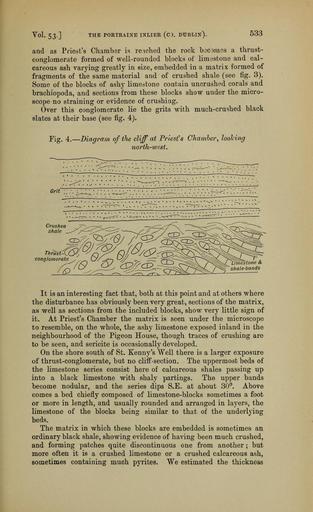MAKE A MEME
View Large Image

| View Original: | The_Quarterly_journal_of_the_Geological_Society_of_London_(12894125574).jpg (1248x2042) | |||
| Download: | Original | Medium | Small | Thumb |
| Courtesy of: | commons.wikimedia.org | More Like This | ||
| Keywords: The Quarterly journal of the Geological Society of London (12894125574).jpg Vol S3 <br> THE PORTRAJNE INLIER C DUBLIN <br> 533 <br> and as Priest's Chamber is reiohed the rock becomes a thrust- <br> conglomerate formed of well-rounded blocks of limestone and cal- <br> careous ash varying greatly in size embedded in a matrix formed of <br> fragments of the same material and of crushed shale see fig 3 <br> Some of the blocks of ashy limestone contain uncrushed corals and <br> brachiopoda and sections from these blocks show under the micro- <br> scope no straining or evidence of crushing <br> Over this conglomerate lie the grits with much-crushed black <br> slates at their base see fig 4 <br> Yig 4 ” Diagram of the cliff at Priest's Chamber looking <br> north-west <br> Thrust <br> conglomerate <br> j9 <br> It is an interesting fact that both at this point and at others where <br> the disturbance has obviously been very great sections of the matrix <br> as well as sections from the included blocks show very little sign of <br> it At Priest's Chamber the matrix is seen under the microscope <br> to resemble on the whole the ashy limestone exposed inland in the <br> neighbourhood of the Pigeon House though traces of crushing are <br> to be seen and sericite is occasionally developed <br> On the shore south of St Kenny's Well there is a larger exposure <br> of thrust-conglomerate but no cliff-section The uppermost beds of <br> the limestone series consist here of calcareous shales passing up <br> into a black limestone with shaly partings The upper bands <br> become nodular and the series dips S E at about 30° Above <br> comes a bed chiefly composed of limestone-blocks sometimes a foot <br> or more in length and usually rounded and arranged in layers the <br> limestone of the blocks being similar to that of the underlying <br> beds <br> The matrix in which these blocks are embedded is sometimes an <br> ordinary black shale showing evidence of having been much crushed <br> and forming patches quite discontinuous one from another ; but <br> more often it is a crushed limestone or a crushed calcareous ash <br> sometimes containing much pyrites We estimated the thickness 36029400 111130 51125 Page 533 Text 53 http //www biodiversitylibrary org/page/36029400 1897 Geological Society of London Biodiversity Heritage Library The Quarterly journal of the Geological Society of London v 53 1897 Geology Periodicals Smithsonian Libraries bhl page 36029400 dc identifier http //biodiversitylibrary org/page/36029400 smithsonian libraries Information field Flickr posted date ISOdate 2014-03-03 Check categories 2015 August 26 CC-BY-2 0 BioDivLibrary https //flickr com/photos/61021753 N02/12894125574 2015-08-26 16 54 19 cc-by-2 0 PD-old-70-1923 The Quarterly journal of the Geological Society of London 1897 Photos uploaded from Flickr by Fæ using a script | ||||